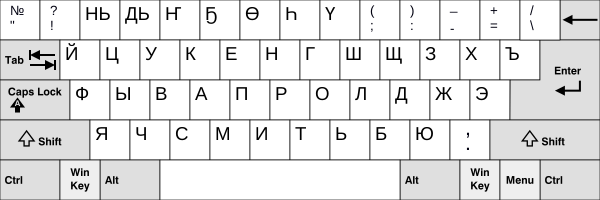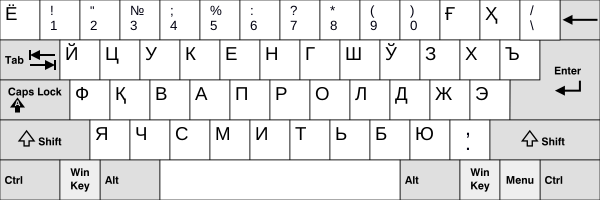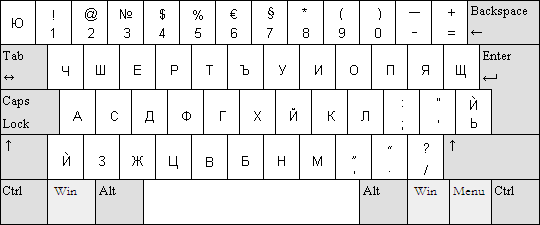JCUKEN: Difference between revisions
→Serbian: switch to SVG version of image |
|||
| (46 intermediate revisions by 31 users not shown) | |||
| Line 1: | Line 1: | ||
{{Short description|Keyboard layout for the Russian language}} |
|||
{{ |
{{more citations needed|date=March 2016}} |
||
'''JCUKEN''' (''ЙЦУКЕН'', also known as ''YCUKEN'', ''YTsUKEN'' and ''JTSUKEN'') is the main [[Cyrillic]] [[keyboard layout]] for the [[Russian language]] in [[computer]]s and [[typewriter]]s. Earlier in [[Russia]] ''JIUKEN'' (''ЙІУКЕН'') layout was the main layout, but it was replaced by JCUKEN when the [[Reforms of Russian orthography|Russian alphabet reform of 1917]] removed the letters [[Ѣ]], [[І]], [[Ѵ]], and [[Ѳ]]. The letter [[Ъ]] had decreased in usage significantly after the reform. |
'''JCUKEN''' (''ЙЦУКЕН'', also known as ''YCUKEN'', ''YTsUKEN'' and ''JTSUKEN'') is the main [[Cyrillic]] [[keyboard layout]]<ref>{{Cite web |title=cyrillic keyboard online |url=https://www.mykeyboard.online/2020/01/russian-keyboard-online-russian-keyboard.html|access-date=2020-01-20 |website=My keyboard |language=en-US |archive-date=2023-12-06 |archive-url=https://web.archive.org/web/20231206214659/https://www.mykeyboard.online/2020/01/russian-keyboard-online-russian-keyboard.html |url-status=live }}</ref> for the [[Russian language]] in [[computer]]s and [[typewriter]]s. Earlier in [[Russia]] ''JIUKEN'' (''ЙІУКЕН'') layout was the main layout, but it was replaced by JCUKEN when the [[Reforms of Russian orthography|Russian alphabet reform of 1917]] removed the letters [[Yat|Ѣ]], [[І]], [[Izhitsa|Ѵ]], and [[Fita|Ѳ]]. The letter [[Ъ]] had decreased in usage significantly after the reform. |
||
Alternative layouts include the Russian [[Phonetic keyboard layout#Phonetic layouts for Russian|phonetic keyboard layout]]s, in which Cyrillic letters correspond to similar-sounding [[Latin-script alphabet|Latin letter]]s in [[QWERTY]] and other layouts. |
|||
== JCUKEN == |
== JCUKEN == |
||
| Line 13: | Line 16: | ||
== JIUKEN == |
== JIUKEN == |
||
The JIUKEN layout was used before the [[Reforms of Russian orthography#The post-revolution reform|Russian spelling reform of 1918]]. It includes the [[Dotted I (Cyrillic)|Cyrillic dotted or "decimal" I]] as well as [[yat]], which were eliminated after the reform, but it does not include the letters [[fita]] and [[izhitsa]], which were rare even before the reform. The numbers [[1]], [[3]] and [[0]] do not appear on the layout and were replaced with the [[decimal I]], [[Ze (Cyrillic)|Ze]], and [[O (Cyrillic)|O]] respectively. The letters [[Ц]] and [[Э]] are located side-by-side, and between the [[Che (Cyrillic)|Che]] and the [[Es (Cyrillic)|Es]] is the [[yat]]. |
The JIUKEN layout was used before the [[Reforms of Russian orthography#The post-revolution reform|Russian spelling reform of 1918]]. It includes the [[Dotted I (Cyrillic)|Cyrillic dotted or "decimal" I]] as well as [[yat]], which were eliminated after the reform, but it does not include the letters [[fita]] and [[izhitsa]], which were rare even before the reform. The numbers [[1]], [[3]] and [[0]] do not appear on the layout and were replaced with the [[decimal I]], [[Ze (Cyrillic)|Ze]], and [[O (Cyrillic)|O]] respectively. The letters [[Ц]] and [[Э]] are located side-by-side, and between the [[Che (Cyrillic)|Che]] and the [[Es (Cyrillic)|Es]] is the [[yat]]. The letter [[Yo (Cyrillic)|yo]] is not included in this layout. |
||
[[File:JIUKEN typewriter.JPG|thumb|600px|center|''ЙІУКЕН'' keyboard layout]] |
[[File:JIUKEN typewriter.JPG|thumb|600px|center|''ЙІУКЕН'' keyboard layout]] |
||
| Line 22: | Line 25: | ||
=== Belarusian === |
=== Belarusian === |
||
The [[Short U (Cyrillic)|short U]] is located in place of the [[shcha]]. It is the only JCUKEN keyboard that lacks a key for [[И]], as it is the only language in the Cyrillic script that does not contain the letter И itself; the [[decimal I]] replaces it. It also lacks a |
The [[Short U (Cyrillic)|short U]] (Ў ў) is located in place of the [[shcha]] (Щ щ). It is the only JCUKEN keyboard that lacks a key for [[И]], as it is the only language in the Cyrillic script that does not contain the letter И itself; the [[decimal I]] (І і) replaces it. It also lacks a [[hard sign]] (Ъ ъ), usually seen just to the right of letter [[Х|ha]] (Х х) as that position is taken by the Apostrophe. |
||
[[File:KB Belarusan.svg|600px|center]] |
[[File:KB Belarusan.svg|600px|center]] |
||
| Line 47: | Line 50: | ||
=== Tajik === |
=== Tajik === |
||
This is a modified version of |
This is a modified version of JCUKEN called YQUKEN, in which the [[Ka with descender]] (Қ қ) substitutes the [[Ц|C]] (Ц ц). The [[yeru]] (Ы ы) is replaced by the letter [[Che with descender]] (Ҷ ҷ). Also, the [[soft sign]] (Ь ь) is replaced by the [[I with macron (Cyrillic)|I with macron]] (Ӣ ӣ). Further, the [[Kha with descender]] (Ҳ ҳ) substitutes for Shcha (Щ щ), and the [[U with macron (Cyrillic)|U with macron]] (Ӯ ӯ), and the [[Ghayn (Cyrillic)|ghayn]] (Ғ ғ) are used. (In Unicode, Kha with descender is known as "Ha with descender".) |
||
[[File:KB Tajik.svg|600px|center]] |
[[File:KB Tajik.svg|600px|center]] |
||
=== Uzbek === |
=== Uzbek === |
||
The [[short U]] substitutes the [[shcha]], like the [[JCUKEN#Belarusian|Belarusian keyboard (see above)]], and the [[ka with descender]] substitutes the [[yery]]. Moreover, the letter [[Ғ|ghayn]] substitutes the [[minus sign]] and the [[underscore]], |
The [[short U]] substitutes the [[shcha]], like the [[JCUKEN#Belarusian|Belarusian keyboard (see above)]], and the [[ka with descender]] substitutes the [[yery]]. Moreover, the letter [[Ғ|ghayn]] substitutes the [[minus sign]] and the [[underscore]], while the [[kha with descender]] substitutes the [[plus sign]] and [[equal sign]]. |
||
[[File:KB Uzbek Cyrillic.svg|600px|center]] |
[[File:KB Uzbek Cyrillic.svg|600px|center]] |
||
=== Azerbaijani === |
=== Azerbaijani === |
||
This layout is a modified version called the JÜUKEN, and includes the [[Che with vertical stroke]], [[shha]], [[Ka with vertical stroke]], and the [[Je (Cyrillic)|Je]]. It is the only JCUKEN without the usual [[Y (Cyrillic)|Й]], as the language lacks the glyph |
This layout is a modified version called the JÜUKEN, and includes the [[Che with vertical stroke]], [[shha]], [[Ka with vertical stroke]], and the [[Je (Cyrillic)|Je]]. It is the only JCUKEN without the usual [[Y (Cyrillic)|Й]], as the language lacks the glyph, which was replaced by [[Je (Cyrillic)|Je]] in 1958. |
||
Substitutions to this keyboard are: having the [[Schwa (Cyrillic)|schwa]] replacing the [[Ya (Cyrillic)|ya]], the [[Oe (Cyrillic)|oe]] replacing the [[Yu (Cyrillic)|yu]], the [[Ghayn (Cyrillic)|ghayn]] replacing the [[soft sign]], the [[Che with vertical stroke]] replacing the [[hard sign]], the [[Ue (Cyrillic)|ue]] replacing the [[Ц|tsa]] and the [[ |
Substitutions to this keyboard are: having the [[Schwa (Cyrillic)|schwa]] replacing the [[Ya (Cyrillic)|ya]], the [[Oe (Cyrillic)|oe]] replacing the [[Yu (Cyrillic)|yu]], the [[Ghayn (Cyrillic)|ghayn]] replacing the [[soft sign]], the [[Che with vertical stroke]] replacing the [[hard sign]], the [[Ue (Cyrillic)|ue]] replacing the [[Ц|tsa]] and the [[shha]] replacing the [[shcha]]. |
||
[[File:KB Azeri Cyrillic.svg|600px|center]] |
[[File:KB Azeri Cyrillic.svg|600px|center]] |
||
| Line 65: | Line 68: | ||
[[File:Mongolian keyboard win.png|600px|center]] |
[[File:Mongolian keyboard win.png|600px|center]] |
||
== Other Cyrillic |
== Other Cyrillic layouts == |
||
=== Serbian === |
=== Serbian === |
||
In the Serbian keyboard LjNjERTZ (ЉЊЕРТЗ), letters of the [[Serbian language]] are used instead of Russian letters. It lacks the [[yer]]s and [[yeru]] (Ъ ъ, Ь ь and Ы ы), [[Э]], and [[Ё]]. It is based on the [[QWERTZ]] keyboard layout. |
|||
[[File:QWERTZ |
[[File:Serbian Cyrillic keyboard layout (QWERTZ) - Српски ћирилични распоред тастатуре.svg|600px|center]] |
||
=== Macedonian === |
=== Macedonian === |
||
Also utilizing a modification of the Serb-style |
Also utilizing a modification of the Serb-style LjNjERTZ (LjNjERTDz), a single "dead key" is used for input for Macedonian letters Gje "Ѓ ѓ" and Kje "Ќ ќ", as well as the typewritten apostrophe (in combination with the spacebar): «м. к. á», «К к» → «Ќ ќ», «м. к. á», «space» → «'». |
||
Macedonian keyboard layouts under Microsoft Windows (KBDMAC.DLL and KBDMACST.DLL) do not use "dead keys". Instead, letters Gje and Kje are present as dedicated keys, and AltGr is used to access additional letters and punctuation. |
Macedonian keyboard layouts under Microsoft Windows (KBDMAC.DLL and KBDMACST.DLL) do not use "dead keys". Instead, letters Gje and Kje are present as dedicated keys, and AltGr is used to access additional letters and punctuation. |
||
| Line 78: | Line 81: | ||
=== Bulgarian === |
=== Bulgarian === |
||
The Bulgarian language utilizes the unique layout ,УЕИШЩ (,UEIShSht) developed for typewriters in the 1900's, with the addition of two Russian letters (Э and Ы) due to vacant keys after spelling reforms. The letter Ы can be typed by Shift + , (comma). The letter [[I with grave (Cyrillic)|Ѝ]] can by typed through Shift + Ь. Because of this, typing capital Ь, Ы and Ѝ is impossible without the use of the Caps Lock key. |
|||
''Standard Bulgarian keyboard from 2006 (YUEIShShch)'' |
|||
In addition, the Bulgarian language has two additional keyboard layoutsː The Phonetic layout ЧШЕРТЪ (ChShERTǍ) and the more widely used Traditional Phonetic layout ЯВЕРТЪ (YaVERTǍ) |
|||
''Standard Cyrillic keyboard layout for Bulgarian in 2006 (Also known as ",УЕИШЩ" (,UEIShSht))'' |
|||
[[File:Keyboard Layout Bulgarian BDS2.png|600px|center]] |
[[File:Keyboard Layout Bulgarian BDS2.png|600px|center]] |
||
''Phonetic Cyrillic keyboard layout for Bulgarian in 2006 (Also known as "ЧШЕРТЪ" |
''Phonetic Cyrillic keyboard layout for Bulgarian in 2006 (Also known as "ЧШЕРТЪ" (ChShERTǍ))'' |
||
[[File:Keyboard Layout Bulgarian Phonetic2.png|600px|center]] |
[[File:Keyboard Layout Bulgarian Phonetic2.png|600px|center]] |
||
''Traditional Phonetic Cyrillic keyboard for Bulgarian in 2006 (Also known as "ЯВЕРТЪ" (YaVERTǍ))'' |
|||
[[File:Keyboard Layout Bulgarian Phonetic.png|Keyboard Layout Bulgarian Phonetic|600px|center]] |
|||
== Latin JCUKEN == |
== Latin JCUKEN == |
||
This was the predominant layout on the Soviet-made [[microcomputer]]s during the 1980s. |
This was the predominant layout on the Soviet-made [[microcomputer]]s during the 1980s - the Cyrillic characters on most keys being supplemented with their Latin equivalents, and punctuation filling gaps where no direct Latin equivalent exists. |
||
[[File: |
[[File:UKNC keyboard.svg|thumb|600px|center|Russian/Latin JCUKEN keyboard of the [[UKNC]] computer]] |
||
=== JCUKEN/QWERTY layout combo === |
|||
Nowadays, however, a different approach is used in keyboards designed for Russian users. Most keyboards in Russia of XXI century have two letters per key, one for JCUKEN and one for QWERTY. This design, for example, was used for the [[Keyboard Monument]]. |
|||
[[File:ES1845_keyboard.jpg|thumb|600px|center|An example of a Russian/Latin mixed keyboard]] |
|||
One can see a design nuance, where two [[homoglyph]]s share one key: Latin [[C]] letter is located on the same key as Cyrillic [[С]]. |
|||
== See also == |
== See also == |
||
*[[QWERTY]] |
*[[QWERTY]] |
||
*[[Ё]] ("yo") letter, often instinctively disregarded by JCUKEN users. |
|||
== References == |
== References == |
||
| Line 95: | Line 115: | ||
{{Keyboard layouts}} |
{{Keyboard layouts}} |
||
{{computer-stub}} |
|||
[[Category:Keyboard layouts]] |
[[Category:Keyboard layouts]] |
||
Latest revision as of 04:56, 3 April 2024
This article needs additional citations for verification. (March 2016) |
JCUKEN (ЙЦУКЕН, also known as YCUKEN, YTsUKEN and JTSUKEN) is the main Cyrillic keyboard layout[1] for the Russian language in computers and typewriters. Earlier in Russia JIUKEN (ЙІУКЕН) layout was the main layout, but it was replaced by JCUKEN when the Russian alphabet reform of 1917 removed the letters Ѣ, І, Ѵ, and Ѳ. The letter Ъ had decreased in usage significantly after the reform.
Alternative layouts include the Russian phonetic keyboard layouts, in which Cyrillic letters correspond to similar-sounding Latin letters in QWERTY and other layouts.
JCUKEN
[edit]PC
[edit]
Typewriters
[edit]Used on typewriters before personal computers. It is available in Microsoft Windows as a legacy layout.

JIUKEN
[edit]The JIUKEN layout was used before the Russian spelling reform of 1918. It includes the Cyrillic dotted or "decimal" I as well as yat, which were eliminated after the reform, but it does not include the letters fita and izhitsa, which were rare even before the reform. The numbers 1, 3 and 0 do not appear on the layout and were replaced with the decimal I, Ze, and O respectively. The letters Ц and Э are located side-by-side, and between the Che and the Es is the yat. The letter yo is not included in this layout.
Other languages
[edit]JCUKEN is the basis for many other Cyrillic layouts. For the current moment Microsoft Windows supports the following layouts: Azerbaijani (Cyrillic), Bashkir, Belarusian, Kazakh, Kyrgyz, Mongolian, Tajik, Ukrainian, Uzbek (Cyrillic), Yakut (Sakha).[2] The Belarusian, Ukrainian and Mongolian layouts have been available since Windows 95; Azeri, Kazakh, Kyrgyz, Tatar, Uzbek since Windows XP; Bashkir and Tajik since Windows Vista; Yakut since Windows 7.
Other operating systems such as Linux may have their own additional custom layouts for the same or other languages.
Belarusian
[edit]The short U (Ў ў) is located in place of the shcha (Щ щ). It is the only JCUKEN keyboard that lacks a key for И, as it is the only language in the Cyrillic script that does not contain the letter И itself; the decimal I (І і) replaces it. It also lacks a hard sign (Ъ ъ), usually seen just to the right of letter ha (Х х) as that position is taken by the Apostrophe.

Ukrainian
[edit]The decimal I replaces the yeru (Ы ы) and the yest (Є є) replaces the E (Э э). The letter Yi (Ї ї) substitutes for the hard sign (Ъ ъ), and Ghe with upturn (Ґ ґ) is also used.

Tatar
[edit]The Russian letters which are rarely used in Tatar are typed with AltGr (right Alt). This layout is also suitable for Kalmyk and Turkmen (Cyrillic) as their alphabets are practically identical to Tatar. It is called as YÖUKEN.

Bashkir
[edit]
Kazakh
[edit]
Kyrgyz
[edit]An "upgraded" version based on the basic Russian one, the additional Kyrgyz letters are typed with AltGr (right Alt). Thus, AltGr + У is Ү, AltGr + О is Ө, and AltGr + Н is Ң.

Yakut (Sakha)
[edit]
Tajik
[edit]This is a modified version of JCUKEN called YQUKEN, in which the Ka with descender (Қ қ) substitutes the C (Ц ц). The yeru (Ы ы) is replaced by the letter Che with descender (Ҷ ҷ). Also, the soft sign (Ь ь) is replaced by the I with macron (Ӣ ӣ). Further, the Kha with descender (Ҳ ҳ) substitutes for Shcha (Щ щ), and the U with macron (Ӯ ӯ), and the ghayn (Ғ ғ) are used. (In Unicode, Kha with descender is known as "Ha with descender".)

Uzbek
[edit]The short U substitutes the shcha, like the Belarusian keyboard (see above), and the ka with descender substitutes the yery. Moreover, the letter ghayn substitutes the minus sign and the underscore, while the kha with descender substitutes the plus sign and equal sign.

Azerbaijani
[edit]This layout is a modified version called the JÜUKEN, and includes the Che with vertical stroke, shha, Ka with vertical stroke, and the Je. It is the only JCUKEN without the usual Й, as the language lacks the glyph, which was replaced by Je in 1958.
Substitutions to this keyboard are: having the schwa replacing the ya, the oe replacing the yu, the ghayn replacing the soft sign, the Che with vertical stroke replacing the hard sign, the ue replacing the tsa and the shha replacing the shcha.

Mongolian
[edit]The Mongolian keyboard uses a modified version of JCUKEN, called FCUZHEN (ФЦУЖЭН), where letters specific to Russian are replaced by letters that see more use in Mongolian.

Other Cyrillic layouts
[edit]Serbian
[edit]In the Serbian keyboard LjNjERTZ (ЉЊЕРТЗ), letters of the Serbian language are used instead of Russian letters. It lacks the yers and yeru (Ъ ъ, Ь ь and Ы ы), Э, and Ё. It is based on the QWERTZ keyboard layout.

Macedonian
[edit]Also utilizing a modification of the Serb-style LjNjERTZ (LjNjERTDz), a single "dead key" is used for input for Macedonian letters Gje "Ѓ ѓ" and Kje "Ќ ќ", as well as the typewritten apostrophe (in combination with the spacebar): «м. к. á», «К к» → «Ќ ќ», «м. к. á», «space» → «'».
Macedonian keyboard layouts under Microsoft Windows (KBDMAC.DLL and KBDMACST.DLL) do not use "dead keys". Instead, letters Gje and Kje are present as dedicated keys, and AltGr is used to access additional letters and punctuation.

Bulgarian
[edit]The Bulgarian language utilizes the unique layout ,УЕИШЩ (,UEIShSht) developed for typewriters in the 1900's, with the addition of two Russian letters (Э and Ы) due to vacant keys after spelling reforms. The letter Ы can be typed by Shift + , (comma). The letter Ѝ can by typed through Shift + Ь. Because of this, typing capital Ь, Ы and Ѝ is impossible without the use of the Caps Lock key.
In addition, the Bulgarian language has two additional keyboard layoutsː The Phonetic layout ЧШЕРТЪ (ChShERTǍ) and the more widely used Traditional Phonetic layout ЯВЕРТЪ (YaVERTǍ)
Standard Cyrillic keyboard layout for Bulgarian in 2006 (Also known as ",УЕИШЩ" (,UEIShSht))

Phonetic Cyrillic keyboard layout for Bulgarian in 2006 (Also known as "ЧШЕРТЪ" (ChShERTǍ))

Traditional Phonetic Cyrillic keyboard for Bulgarian in 2006 (Also known as "ЯВЕРТЪ" (YaVERTǍ))

Latin JCUKEN
[edit]This was the predominant layout on the Soviet-made microcomputers during the 1980s - the Cyrillic characters on most keys being supplemented with their Latin equivalents, and punctuation filling gaps where no direct Latin equivalent exists.

JCUKEN/QWERTY layout combo
[edit]Nowadays, however, a different approach is used in keyboards designed for Russian users. Most keyboards in Russia of XXI century have two letters per key, one for JCUKEN and one for QWERTY. This design, for example, was used for the Keyboard Monument.

One can see a design nuance, where two homoglyphs share one key: Latin C letter is located on the same key as Cyrillic С.
See also
[edit]References
[edit]- ^ "cyrillic keyboard online". My keyboard. Archived from the original on 2023-12-06. Retrieved 2020-01-20.
- ^ "Windows Keyboard Layouts". Microsoft. 2017.
